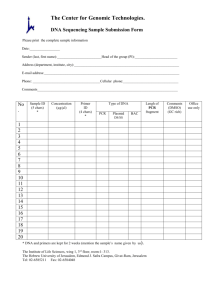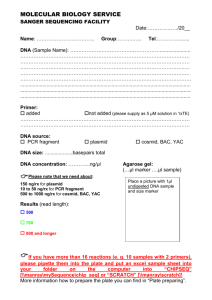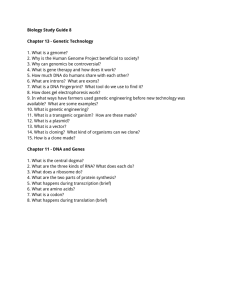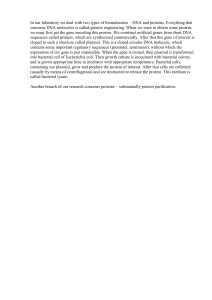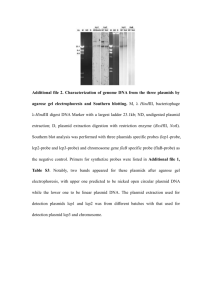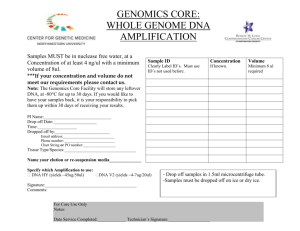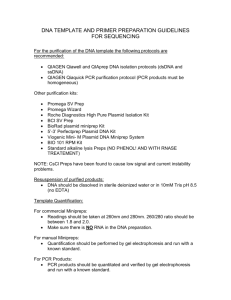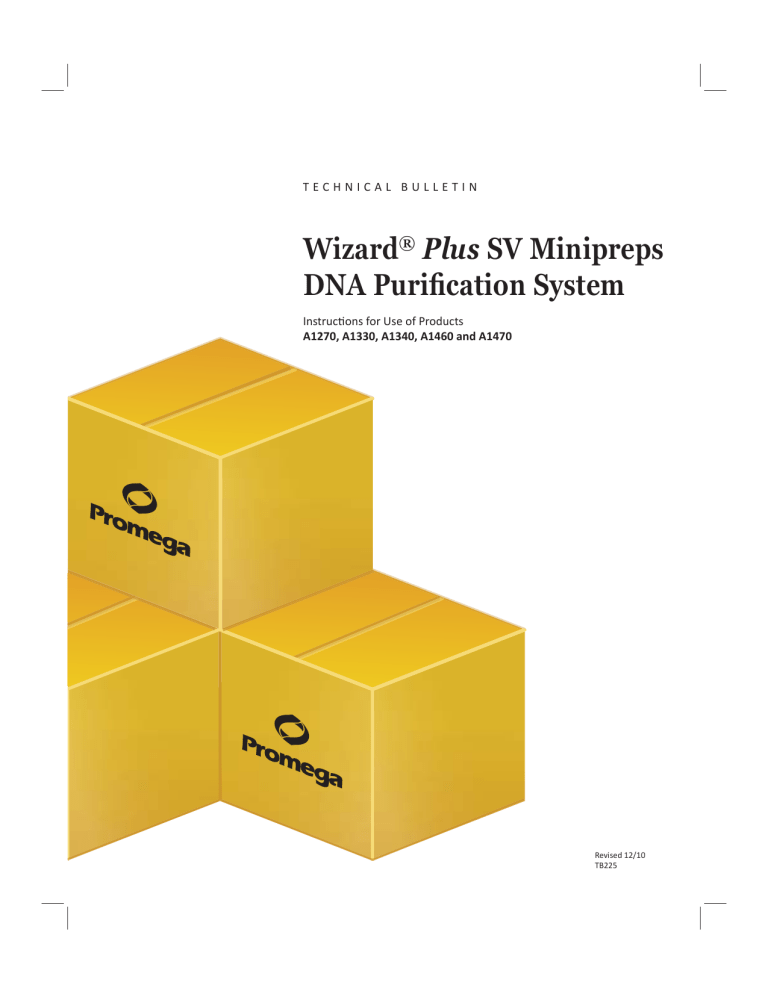
TECHNICAL BULLETIN
Wizard® Plus SV Minipreps
DNA Purification System
InstrucƟons for Use of Products
A1270, A1330, A1340, A1460 and A1470
Revised 12/10
TB225
Wizard® Plus SV Minipreps
DNA Purification System
All technical literature is available at: www.promega.com/protocols/
Visit the web site to verify that you are using the most current version of this Technical Bulletin.
E-mail Promega Technical Services if you have questions on use of this system: techserv@promega.com
1. Description......................................................................................................................................... 1
2. Product Components and Storage Conditions ........................................................................................ 3
3. Protocols ............................................................................................................................................ 4
3.A. Preparation of E. coli............................................................................................................................. 4
3.B. Production of a Cleared Lysate..................................................................................................... 5
3.C. Plasmid DNA Isolation and Purification Protocols ........................................................................ 6
4. Supplementary Information ................................................................................................................. 8
4.A. Selection and Preparation of Plasmids and E. coli Strains ............................................................. 8
4.B. Choosing a Bacterial Strain ......................................................................................................... 8
4.C. Use of Alkaline Protease .............................................................................................................. 9
4.D. Considerations for Automated Fluorescent Sequencing................................................................ 10
5. Troubleshooting................................................................................................................................ 11
6. Composition of Buffers and Solutions ................................................................................................. 13
7. References ........................................................................................................................................ 14
8. Related Products ............................................................................................................................... 14
1.
Description
The Wizard® Plus SV Minipreps DNA Purification System(a,b) provides a simple, reliable method for rapid isolation of
plasmid DNA (Figure 1). The entire miniprep procedure can be completed in 30 minutes or less, depending on the
number of samples processed. This system can be used to isolate any plasmid from E. coli hosts but works most
efficiently when the plasmid is less than 20,000bp in size. Purified plasmids can be used without further manipulation
for automated fluorescent DNA sequencing as well as for other standard molecular biology techniques. When used for
in vitro transcription reactions, the isolated plasmid DNA should be supplemented with a ribonuclease inhibitor such
as Recombinant RNasin® Ribonuclease Inhibitor (Cat.# N2511).
The protocol presented in this Technical Bulletin is for isolation of plasmid DNA from E. coli. Plasmid DNA can be
purified from 1–10ml overnight cultures with the Wizard® Plus SV Minipreps DNA Purification System. Plasmid yield
will vary depending on a number of factors, including culture volume, plasmid copy number, type of culture medium
and the bacterial strain used.
Promega CorporaƟon · 2800 Woods Hollow Road · Madison, WI 53711-5399 USA · Toll Free in USA 800-356-9526 · 608-274-4330 · Fax 608-277-2516
www.promega.com
TB225 · Revised 12/10
1
Overnight culture
Centrifuge.
Remove culture media.
Resuspend cells.
Lyse cells.
Neutralize.
Clear lysate.
Transfer lysate.
Bind DNA.
Wash, removing solution by
centrifugation or vacuum.
Transfer Spin Column to a
Collection Tube. Centrifuge.
1581MA09_9A
Elute plasmid DNA.
Figure 1. Flow diagram of plasmid DNA isolation and purification using the Wizard® Plus SV Minipreps
DNA Purification System.
2
Promega CorporaƟon · 2800 Woods Hollow Road · Madison, WI 53711-5399 USA · Toll Free in USA 800-356-9526 · 608-274-4330 · Fax 608-277-2516
TB225 · Revised 12/10
www.promega.com
2.
Product Components and Storage Conditions
PRODUCT
Wizard® Plus SV Minipreps DNA PurificaƟon System (with Vacuum Adapters)
SIZE
C A T. #
50 preps
A1340
Each system contains sufficient reagents for 50 isolations from 1–10ml of culture. Includes:
•
•
•
•
•
•
•
•
•
20ml
20ml
30ml
20ml
50
50
550µl
13ml
20
Cell Resuspension Solution (CRA)
Cell Lysis Solution (CLA)
Neutralization Solution (NSB)
Column Wash Solution (CWA)
Wizard® SV Minicolumns
Collection Tubes (2ml)
Alkaline Protease Solution
Nuclease-Free Water
Vacuum Adapters
PRODUCT
Wizard® Plus SV Minipreps DNA PurificaƟon System (with Vacuum Adapters)
SIZE
C A T. #
250 preps
A1470
Each system contains sufficient reagents for 250 isolations from 1–10ml of culture. Includes:
•
•
•
•
•
•
•
•
•
75ml
75ml
100ml
100ml
250
250
2,700µl
25ml
20
Cell Resuspension Solution (CRA)
Cell Lysis Solution (CLA)
Neutralization Solution (NSB)
Column Wash Solution (CWA)
Wizard® SV Minicolumns
Collection Tubes (2ml)
Alkaline Protease Solution
Nuclease-Free Water
Vacuum Adapters
PRODUCT
Wizard® Plus SV Minipreps DNA PurificaƟon System
SIZE
C A T. #
50 preps
A1330
250 preps
A1460
Note: Cat.# A1330 and A1460 contain the same components as Cat.# A1340 and A1470, respectively, but
do not include Vacuum Adapters.
PRODUCT
Wizard® Plus SV Minipreps DNA PurificaƟon System, Trial Size
SIZE
C A T. #
10 preps
A1270
Each system contains sufficient reagents for 10 isolations from 1–10ml of culture (including Vacuum
Adapters).
Storage and Stability: Store all Wizard® Plus SV Minipreps components at room temperature (15–30°C). Reagent
expiration dates are listed on the product label.
Promega CorporaƟon · 2800 Woods Hollow Road · Madison, WI 53711-5399 USA · Toll Free in USA 800-356-9526 · 608-274-4330 · Fax 608-277-2516
www.promega.com
TB225 · Revised 12/10
3
3.
!
Protocols
Do not exchange or replace components of the Wizard® Plus SV Minipreps DNA Purification System with components
from any other Wizard® Plus System. Components from the Wizard® Plus and Wizard® Plus SV Systems are not
interchangeable.
Materials to Be Supplied by the User
(Solution compositions are provided in Section 6.)
•
LB agar plates containing antibiotic
•
LB medium containing antibiotic
•
ethanol (95%)
•
microcentrifuge capable of 14,000 × g
•
sterile 1.5ml microcentrifuge tubes
•
centrifuge capable of 10,000 × g
Prior to using a new Wizard® Plus SV Minipreps DNA Purification System, dilute the provided Column
Wash Solution (CWA) as follows:
Add 7ml of 95% ethanol for a final volume of 11ml for the 10-prep system (Cat.# A1270).
Add 35ml of 95% ethanol for a final volume of 55ml for the 50-prep system (Cat.# A1330 and A1340).
Add 170ml of 95% ethanol for a final volume of 270ml for the 250-prep system (Cat.# A1460 and A1470).
3.A. Preparation of E. coli
1.
Use a single, well isolated colony from a fresh Luria-Bertani (LB) agar plate (containing antibiotic) to inoculate
1–10ml of LB medium (containing the same antibiotic). We recommend LB culture medium. Rich media, such as
Terrific Broth, produce high cell densities that may overload the DNA purification system.
2.
Incubate overnight (12–16 hours) at 37°C in a shaking incubator. Incubation time can be optimized to increase
the plasmid DNA yield for a given culture volume. However, it has been observed that as a culture ages the DNA
yield may begin to decrease due to cell death and lysis within the culture.
Note: An A600 reading of 2–4 ensures that cells have reached the proper growth density for harvesting and plasmid
DNA isolation.
For high-copy-number plasmids, do not process more than 5ml of bacterial culture. If more than 5ml of culture is
processed, the capacity of the Wizard® SV Minicolumn will be exceeded and no increase in plasmid yield will be
obtained.
For low-copy-number plasmids, it may be necessary to process larger volumes of bacterial culture (up to 10ml) for
recovery of sufficient DNA. Processing greater than 10ml of culture will lead to insufficient clearing of the bacterial
lysate and thus increased contaminants in the plasmid DNA.
4
Promega CorporaƟon · 2800 Woods Hollow Road · Madison, WI 53711-5399 USA · Toll Free in USA 800-356-9526 · 608-274-4330 · Fax 608-277-2516
TB225 · Revised 12/10
www.promega.com
3.B. Production of a Cleared Lysate
Note: Throughout the remainder of this document, the supplied Cell Resuspension Solution (CRA),
Cell Lysis Solution (CLA), Neutralization Solution (NSB) and Column Wash Solution (CWA) are referred to as
Cell Resuspension Solution, Cell Lysis Solution, Neutralization Solution and Column Wash Solution, respectively.
1.
Harvest 1–5ml (high-copy-number plasmid) or 10ml (low-copy-number plasmid) of bacterial culture by
centrifugation for 5 minutes at 10,000 x g in a tabletop centrifuge. Pour off the supernatant and blot the inverted
tube on a paper towel to remove excess media.
2.
Add 250µl of Cell Resuspension Solution and completely resuspend the cell pellet by vortexing or pipetting.
It is essential to thoroughly resuspend the cells. If they are not already in a microcentrifuge tube, transfer
the resuspended cells to a sterile 1.5ml microcentrifuge tube(s).
!
3.
Note: To prevent shearing of chromosomal DNA, do not vortex after Step 2. Mix only by inverting the tubes.
Add 250µl of Cell Lysis Solution and mix by inverting the tube 4 times (do not vortex). Incubate until the cell
suspension clears (approximately 1–5 minutes).
Note: It is important to observe partial clearing of the lysate before proceeding to addition of the Alkaline
Protease Solution (Step 4); however, do not incubate for longer than 5 minutes.
4.
!
Add 10µl of Alkaline Protease Solution and mix by inverting the tube 4 times. Incubate for 5 minutes at
room temperature.
Alkaline protease inactivates endonucleases and other proteins released during the lysis of the bacterial cells that
can adversely affect the quality of the isolated DNA. Do not exceed 5 minutes of incubation with Alkaline
Protease Solution at Step 4, as nicking of the plasmid DNA may occur.
5.
Add 350µl of Neutralization Solution and immediately mix by inverting the tube 4 times (do not vortex).
6.
Centrifuge the bacterial lysate at maximum speed (around 14,000 × g) in a microcentrifuge for 10 minutes at
room temperature.
Promega CorporaƟon · 2800 Woods Hollow Road · Madison, WI 53711-5399 USA · Toll Free in USA 800-356-9526 · 608-274-4330 · Fax 608-277-2516
www.promega.com
TB225 · Revised 12/10
5
3.C. Plasmid DNA Isolation and Purification Protocols
The Wizard® Plus SV Minipreps DNA Purification System allows a choice of methods for purification of plasmid DNA
when systems with Vacuum Adapters are purchased (Cat.# A1340, A1470). Plasmid DNA may be purified from the
bacterial lysate using microcentrifugation to force the cleared lysate through the Wizard® SV Minicolumn and wash
the plasmid DNA. Alternatively, a vacuum can be used to pull the lysate through the Spin Column and wash the
plasmid DNA. Vacuum Adapters allow the use of a vacuum manifold (e.g., a Vac-Man® Laboratory Vacuum Manifold)
and vacuum source for DNA purification.
Centrifugation Protocol
Prepare plasmid DNA purification units by inserting one Spin Column into one 2ml Collection Tube for each sample.
1.
Transfer the cleared lysate (approximately 850µl, Section 3.B, Step 6) to the prepared Spin Column by
decanting. Avoid disturbing or transferring any of the white precipitate with the supernatant.
Note: If the white precipitate is accidentally transferred to the Spin Column, pour the Spin Column contents
back into a sterile 1.5ml microcentrifuge tube and centrifuge for another 5–10 minutes at maximum speed.
Transfer the resulting supernatant into the same Spin Column that was used initially for this sample. The
Spin Column can be reused but only for this sample.
2.
Centrifuge the supernatant at maximum speed in a microcentrifuge for 1 minute at room temperature. Remove
the Spin Column from the tube and discard the flowthrough from the Collection Tube. Reinsert the Spin Column
into the Collection Tube.
3.
Add 750µl of Column Wash Solution, previously diluted with 95% ethanol, to the Spin Column.
4.
Centrifuge at maximum speed in a microcentrifuge for 1 minute at room temperature. Remove the Spin Column
from the tube and discard the flowthrough. Reinsert the Spin Column into the Collection Tube.
5.
Repeat the wash procedure using 250µl of Column Wash Solution.
6.
Centrifuge at maximum speed in a microcentrifuge for 2 minutes at room temperature.
7.
Transfer the Spin Column to a new, sterile 1.5ml microcentrifuge tube, being careful not to transfer any of the
Column Wash Solution with the Spin Column. If the Spin Column has Column Wash Solution associated with it,
centrifuge again for 1 minute at maximum speed.
8.
Transfer the Spin Column to a new, sterile 1.5ml microcentrifuge tube.
9.
Elute the plasmid DNA by adding 100µl of Nuclease-Free Water to the Spin Column. Centrifuge at maximum
speed for 1 minute at room temperature in a microcentrifuge.
10.
After eluting the DNA, remove the assembly from the 1.5ml microcentrifuge tube and discard the Spin Column.
11.
DNA is stable in water without addition of a buffer if stored at –20°C or below. DNA is stable at 4°C in TE
buffer. To store the DNA in TE buffer, add 11µl of 10X TE buffer to the 100µl of eluted DNA. Do not add TE
buffer if the DNA is to be used for automated fluorescent sequencing.
12.
Cap the microcentrifuge tube and store the purified plasmid DNA at –20°C or below.
6
Promega CorporaƟon · 2800 Woods Hollow Road · Madison, WI 53711-5399 USA · Toll Free in USA 800-356-9526 · 608-274-4330 · Fax 608-277-2516
TB225 · Revised 12/10
www.promega.com
Vacuum Protocol
Attach one Vacuum Adapter with Luer-Lok® fitting to one port of the manifold (e.g., a Vac-Man® Laboratory Vacuum
Manifold). Insert a Spin Column into the Vacuum Adapter until snugly in place.
1.
Transfer the cleared lysate (approximately 850µl, Section 3.B, Step 6) to the prepared Spin Column by
decanting. Avoid disturbing or transferring any of the white precipitate with the supernatant.
Note: If the white precipitate is accidentally transferred to the Spin Column, pour the Spin Column contents
back into a sterile 1.5ml microcentrifuge tube and centrifuge for another 5–10 minutes at maximum speed.
Transfer the resulting supernatant into the same Spin Column that was used initially for this sample. The
Spin Column can be reused but only for this sample.
2.
Apply a vacuum of at least 15 inches of mercury (Hg) to pull the liquid
through the Spin Column. When all liquid has been pulled through the
column, release the vacuum.
3.
Add 750µl of the Column Wash Solution, previously diluted with
95% ethanol, to the Spin Column.
4.
Apply a vacuum to pull the Column Wash Solution through the Spin
Column. When all the liquid has been pulled through the Spin Column,
release the vacuum.
Comparison of Inches of Hg to
Other Pressure Measurements.
15 Inches Hg
50.8kPa
381Torr
0.501atm
7.37psi
38.1cm Hg
5.
Repeat the wash procedure using 250µl of Column Wash Solution.
Apply a vacuum to pull the liquid through the Spin Column.
6.
Dry the Spin Column by applying a vacuum for 10 minutes.
7.
Turn off the vacuum and transfer the Spin Column to a 2ml Collection Tube. Centrifuge at maximum speed
for 2 minutes to remove any residual Column Wash Solution. Discard the 2ml Collection Tube and any liquid
collected during this step.
8.
Transfer the Spin Column to a new, sterile 1.5ml microcentrifuge tube.
9.
Elute the plasmid DNA by adding 100µl of Nuclease-Free Water to the Spin Column. Centrifuge at maximum
speed for 1 minute at room temperature in a microcentrifuge.
10.
After eluting the DNA, remove the assembly from the 1.5ml microcentrifuge tube and discard the Spin Column.
11.
DNA is stable in water without addition of a buffer if stored at –20°C or below. DNA is stable at 4°C in TE
buffer. To store the DNA in TE buffer, add 11µl of 10X TE buffer to the 100µl of eluted DNA. Do not add TE
buffer if the DNA is to be used for automated fluorescent sequencing.
12.
Cap the microcentrifuge tube and store the purified plasmid DNA at –20°C or below.
508mbar
Promega CorporaƟon · 2800 Woods Hollow Road · Madison, WI 53711-5399 USA · Toll Free in USA 800-356-9526 · 608-274-4330 · Fax 608-277-2516
www.promega.com
TB225 · Revised 12/10
7
4.
Supplementary Information
4.A. Selection and Preparation of Plasmids and E. coli Strains
Plasmid DNA can be purified from overnight cultures of E. coli with the Wizard® Plus SV Minipreps DNA Purification
System. The yield of plasmid will vary depending on a number of factors, including the plasmid copy number, cell
density of bacterial culture, type of culture medium and bacterial strain used.
Plasmid copy number is an important factor affecting DNA yield. Copy number is determined primarily by the region of
DNA surrounding and including the origin of replication. This region, known as the replicon, controls replication of
plasmid DNA by bacterial enzyme complexes. Some DNA sequences, when inserted into a particular plasmid, can lower
the copy number of the plasmid by interfering with replication.
Choose a single, well-isolated colony from a fresh Luria-Bertani (LB) agar plate (containing antibiotic) and use the
colony to inoculate 1–10ml of LB media (also containing antibiotic). The inoculated medium should be incubated
overnight (12–16 hours) at 37°C. An A600 of 2.0–4.0 for high-copy-number plasmids ensures that bacteria have
reached the proper growth density for harvesting and plasmid DNA isolation.
4.B. Choosing a Bacterial Strain
Endonuclease I is a 12kDa periplasmic protein that degrades double-stranded DNA. This protein is encoded by the
gene endA. The E. coli genotype endA1 refers to a mutation in the wildtype endA gene, which produces an inactive
form of the nuclease. E. coli strains with this mutation are referred to as EndA–. Table 1 contains a list of EndA– and
EndA+ E. coli strains.
The absence of endA1 (or endA) in an E. coli genotype denotes the presence of the wildtype gene, which expresses an
active endonuclease I. The wildtype is indicated as EndA+. Using the Wizard® Plus SV Minipreps DNA Purification
System, high-quality DNA is easily obtained from both EndA+ and EndA– strains. However, some EndA+ strains can be
problematic for a number of applications. In general, we recommend the use of EndA– strains whenever possible,
particularly for applications such as automated fluorescent sequencing.
For applications such as fluorescent DNA sequencing, special considerations should be given to the selection of plasmid
and E. coli strains to optimize yield and plasmid quality. Optimal automated fluorescent sequencing results are
obtained by using high-copy-number plasmids and EndA– strains of E. coli for plasmid propagation.
8
Promega CorporaƟon · 2800 Woods Hollow Road · Madison, WI 53711-5399 USA · Toll Free in USA 800-356-9526 · 608-274-4330 · Fax 608-277-2516
TB225 · Revised 12/10
www.promega.com
Table 1. EndA– and EndA+ Strains of E. coli.
EndA–
EndA+
BJ5183
BL21(DE3)
DH1
CJ236
DH20
HB101
DH21
JM83
DH5™
JM101
JM103
JM110
JM105
LE392
JM106
MC1061
JM107
NM522 (all NM series strains are EndA+)
JM108
NM554
JM109
P2392
MM294
PR700 (all PR series strains are EndA+)
SK1590
Q358
SK1592
RR1
SK2267
TB1
SRB
TG1
TOP10
Y1088 (all Y10 series strains are EndA+)
XL1-Blue
BMH 71-18
XLO
ES1301
4.C. Use of Alkaline Protease
To improve the quality of plasmid DNA isolated from both EndA+ and EndA– strains of E. coli, the Wizard® Plus SV
Minipreps DNA Purification System includes an alkaline protease solution. Alkaline protease, originally identified as
subtilisin Carlsberg, is isolated from the bacterium Bacillus licheniformis (1). Approximately 250µg are added per
sample at the end of the lysis step during the preparation of a cleared bacterial lysate to inactivate endonucleases. The
alkaline protease also acts to nonspecifically degrade proteins, thus reducing the overall level of protein contaminants
in the cleared bacterial lysate (2,3).
Alkaline protease is useful in this procedure, because it is optimally active at pH 9 and above, the conditions present
during the alkaline lysis procedure. When the lysate is neutralized, alkaline protease activity is substantially reduced
(4,5).
The DNA prepared by this procedure has been tested extensively in a range of molecular biology applications including
fluorescent sequencing, restriction enzyme digestion and cloning.
Promega CorporaƟon · 2800 Woods Hollow Road · Madison, WI 53711-5399 USA · Toll Free in USA 800-356-9526 · 608-274-4330 · Fax 608-277-2516
www.promega.com
TB225 · Revised 12/10
9
4.D. Considerations for Automated Fluorescent Sequencing
For the application of automated fluorescent sequencing, special consideration should be given to the selection of
plasmid type and E. coli strain to optimize yield and plasmid quality.
Note: Optimal automated fluorescent sequencing results are routinely obtained by using high-copy-number plasmids
and EndA– strains of E. coli.
Purified plasmid DNA must be within the proper concentration range for successful automated cycle sequencing
(ideally 0.2µg/µl and not less than 0.1µg/µl). When working with DNA from low-copy-number plasmids, we strongly
recommend that DNA concentration be determined by agarose gel/ethidium bromide quantitation prior to any
application (6). DNA quantitation by spectrophotometric methods is prone to errors and requires a large amount of
sample.
The Wizard® Plus SV Minipreps System routinely yields 3.5–5.0µg of plasmid DNA when using a pGEM® Vector and
DH5α™ cells in 1.5ml of LB medium. For low-copy-number plasmids, a larger culture volume is required to obtain
sufficient DNA for sequencing. Typical low-copy-number plasmid yields are 1.5–3.0µg of plasmid DNA from 10ml of
LB culture medium using the pALTER®-1 Vector and DH5α™ cells.
Special Considerations for Sequencing Using BigDye® Chemistry
The Wizard® Plus SV Minipreps System yields template suitable for use in a number of fluorescent dye sequencing
methods, including BigDye® terminator reactions (Applied Biosystems).
When performing dilutions of the BigDye® terminator-ready reaction mix, it is essential to dilute the reaction mix
using the appropriate dilution buffer (250mM Tris-HCl [pH 9.0], 10mM MgCl2).
When using high-copy-number plasmids, over 500 bases of readable sequence can be obtained from terminator-ready
reaction mixes diluted as much as sixfold.
Table 2 outlines the amount of terminator-ready reaction mix and dilution buffer required to obtain the appropriate
dilution for BigDye® terminator reactions. For details on running these reactions, please refer to the protocol supplied
with the BigDye® terminator system. For each reaction, add the reagents in Table 2 to a separate tube.
Table 2. Appropriate Dilutions for BigDye® Terminator Reactions.
Amount
Component
terminator-ready reaction mix*
double-stranded plasmid DNA template
primer
dilution buffer**
Nuclease-Free Water to a final volume of
No Dilution
1:2
1:4
1:6
8.0µl
4.0µl
2.0µl
1.3µl
200–500ng
200–500ng
200–500ng
200–500ng
3.2pmol
3.2pmol
3.2pmol
3.2pmol
0µl
2.0µl
3.0µl
3.4µl
20µl
20µl
20µl
20µl
*Terminator-ready reaction mix is a 2.5X solution.
**Dilution buffer is a 5X solution.
10
Promega CorporaƟon · 2800 Woods Hollow Road · Madison, WI 53711-5399 USA · Toll Free in USA 800-356-9526 · 608-274-4330 · Fax 608-277-2516
TB225 · Revised 12/10
www.promega.com
5.
Troubleshooting
For questions not addressed here, please contact your local Promega Branch Office or Distributor. Contact information
available at: www.promega.com. E-mail: techserv@promega.com
Symptoms
Poor cell lysis
Causes and Comments
Too many bacterial cells. Use cultures grown to an A600 of 2–4.
All media should contain an antibiotic. Use only recommended
culture volumes for low- and high-copy-number plasmids
(10ml maximum for low-copy-number and 5ml maximum for
high-copy-number plasmids).
Poor resuspension of bacterial cell pellet. Thoroughly resuspend
cell pellets prior to cell lysis. Vortex or pipet pellet with Cell
Resuspension Solution. No cell clumps should be visible after
resuspension.
No plasmid DNA purified
Ethanol was not added to Column Wash Solution. Prepare the
Column Wash Solution as instructed in Section 3 before
beginning the procedure.
Inaccurate quantitation of plasmid DNA yield. Quantitate
plasmid DNA yield via agarose gel/ethidium bromide
electrophoresis.
DNA floats out of the wells during gel loading. Be certain to
allow the full ten minutes for drying (with vacuum protocol)
after the final wash step to allow evaporation of any remaining
ethanol.
Increase loading dye concentration.
Low-copy-number plasmid used. Use a high- copy-number
plasmid.
Low plasmid DNA yields
Overgrowth of bacterial culture by non-transformed cells. Make
certain that antibiotics are used in all media, both liquid and
solid.
Bacterial culture too old. Inoculate antibiotic-containing media
with a freshly isolated bacterial colony from an overnight plate.
Incubate at 37°C for 12–16 hours.
Low-copy-number plasmid used. Know the copy number of
plasmid used; we recommend use of high-copy-number
plasmids.
Plasmid DNA yield not accurately quantitated. Use agarose
gel/ethidium bromide quantitation. Do not rely on spectrophotometric measurement.
Promega CorporaƟon · 2800 Woods Hollow Road · Madison, WI 53711-5399 USA · Toll Free in USA 800-356-9526 · 608-274-4330 · Fax 608-277-2516
www.promega.com
TB225 · Revised 12/10
11
5.
Troubleshooting (continued)
Symptoms
Nicking of plasmid DNA
Causes and Comments
Overincubation during alkaline lysis. Do not exceed 5 minutes of
incubation with either Cell Lysis Solution or Alkaline Protease.
Poor results with automated
fluorescent sequencing
Too little DNA added to the sequencing reaction. Inoculate
fresh LB medium with a newly isolated E. coli colony. Purify
plasmid DNA and quantitate by agarose gel/ethidium bromide
electrophoresis.
TE buffer was used for DNA elution. Repurify plasmid DNA and
elute in Nuclease-Free Water.
Plasmid concentration not accurately quantitated. Use ethidium
bromide gel electrophoresis to accurately quantitate plasmid
DNA.
No restriction digestion
Concentration of restriction enzyme or digestion time need to be
increased. Increase the amount of restriction enzyme or the
length of incubation. Digest at the recommended temperature
and in the optimal buffer for the restriction enzyme used.
Ethanol precipitate the plasmid DNA to remove any salts that
may have carried over.
Genomic DNA contamination
Vortexing or overmixing resulted in genomic DNA
contamination. Do not vortex samples after addition of
Cell Lysis Solution to prevent shearing of genomic DNA.
Wrong reagents used. Make certain that Column Wash Solution
has been diluted with ethanol before use. Note: Wizard® Plus
and Wizard® Plus SV components are not interchangeable.
DNA yields on gel look low compared
to spectrophotometric readings
12
Traces of contaminants may be present in the eluted DNA,
which inflate spectrophotometer readings. Phenol:chloroform
extract and ethanol precipitate DNA, then wash with 70%
ethanol before repeating readings. Quantitate DNA by agarose
gel/ethidium bromide electrophoresis for the most accurate
results.
Promega CorporaƟon · 2800 Woods Hollow Road · Madison, WI 53711-5399 USA · Toll Free in USA 800-356-9526 · 608-274-4330 · Fax 608-277-2516
TB225 · Revised 12/10
www.promega.com
6.
Composition of Buffers and Solutions
5X dilution buffer
250mM Tris-HCl (pH 9.0)
10mM MgCl2
10X TE buffer
100mM Tris-HCl (pH 7.5)
10mM EDTA
LB medium
10g
5g
5g
15g
casein peptone
yeast extract
NaCl
agar (for plates only)
Dissolve in 1L of distilled water. Autoclave and cool to 55°C before adding antibiotic.
Cell Lysis Solution (CLA)
0.2M NaOH
1% SDS
Cell Resuspension Solution (CRA)
50mM Tris-HCl (pH 7.5)
10mM EDTA
100µg/ml RNase A
Neutralization Solution (NSB)
4.09M guanidine hydrochloride
0.759M potassium acetate
2.12M glacial acetic acid
Final pH is approximately 4.2.
Column Wash Solution (CWA)
162.8mM potassium acetate
22.6mM Tris-HCl (pH 7.5)
0.109mM EDTA (pH 8.0)
Add 35ml of 95% ethanol for the 50-prep system (170ml for the 250-prep system, 7ml for the 10-prep system)
as described in Section 3. Final concentrations will be approximately 60% ethanol, 60mM potassium acetate,
8.3mM Tris-HCl, 0.04mM EDTA.
Promega CorporaƟon · 2800 Woods Hollow Road · Madison, WI 53711-5399 USA · Toll Free in USA 800-356-9526 · 608-274-4330 · Fax 608-277-2516
www.promega.com
TB225 · Revised 12/10
13
7.
References
1.
Guntelberg, A.V. and Otteson, M. (1954) Purification of the proteolytic enzyme from Bacillus subtilis. Compt.
Rend. Trav. Lab. Carlsberg 29, 36–48.
2.
Aehle, W. et al. (1993) Rational protein engineering and industrial application: Structure prediction by homology and rational design of protein-variants with improved ‘washing performance’—the alkaline protease from
Bacillus alcalophilus. J. Biotechnol. 28, 31–40.
3.
von der Osten, C. et al. (1993) Protein engineering of subtilisins to improve stability in detergent formulations.
J. Biotechnol. 28, 55–68.
4.
Vetter, R. et al. (1994) Highly alkaline proteases. U.S. Pat. No. 5,352,603. (October 4, 1994).
5.
Shetty, J.K., Patel, C.P. and Nicholson, M.A. (1995) Method of preparation of purified alkaline protease. U.S.
Pat. No. 5,439,817. (August 8, 1995).
6.
Kahn, M. et al. (1979) Plasmid cloning vehicles derived from plasmids ColE1, F, R6K, and RK2. Meth. Enzymol.
68, 268–80.
8.
Related Products
Product
Size
Cat.#
Alkaline Protease Solution
3ml
A1441
Wizard® SV 96 Plasmid DNA Purification System
Wizard® SV 9600 Plasmid DNA Purification System
Vac-Man® Laboratory Vacuum Manifold
Vac-Man® 96 Vacuum Manifold
Vacuum Adapters
PureYield™ Plasmid Midiprep System
14
1 × 96 preps
A2250
5 × 96 preps
A2255
100 × 96 preps
A2258
20-sample capacity
A7231
2-sample capacity
A7660
96-well capacity
A2291
20 each
A1331
25 preps
A2492
100 preps
A2495
Promega CorporaƟon · 2800 Woods Hollow Road · Madison, WI 53711-5399 USA · Toll Free in USA 800-356-9526 · 608-274-4330 · Fax 608-277-2516
TB225 · Revised 12/10
www.promega.com
(a)
Australian Pat. No. 730718, Singapore Pat. No. 64532 and Korean Pat. No. 486402 have been issued to Promega CorporaƟon for an improved filtraƟon
system and method. Other patents are pending.
(b)
U.S. Pat. No. 5,981,235, Australian Pat. No. 729932 and European Pat. No. 0 918 877 have been issued to Promega CorporaƟon for methods for
isolaƟng nucleic acids using alkaline protease. Other patents are pending.
© 2010 Promega CorporaƟon. All Rights Reserved.
pALTER, pGEM, RNasin, Vac-Man and Wizard are registered trademarks of Promega CorporaƟon. PureYield is a trademark of Promega CorporaƟon.
BigDye is a registered trademark of Applera CorporaƟon. DH5a is a trademark of Life Technologies, Inc. Luer-Lok is a registered trademark of Becton,
Dickinson and Company.
Products may be covered by pending or issued patents or may have certain limitaƟons. Please visit our web site for more informaƟon.
All prices and specificaƟons are subject to change without prior noƟce.
Product claims are subject to change. Please contact Promega Technical Services or access the Promega online catalog for the most up-to-date
informaƟon on Promega products.
Promega CorporaƟon · 2800 Woods Hollow Road · Madison, WI 53711-5399 USA · Toll Free in USA 800-356-9526 · 608-274-4330 · Fax 608-277-2516
www.promega.com
TB225 · Revised 12/10
15

